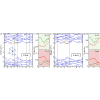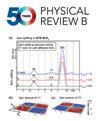稀土瑀包晶石中阳离子间 d-d 耦合诱导的间接-直接带隙转变
IF 3.7
2区 物理与天体物理
Q1 Physics and Astronomy
引用次数: 0
摘要
钙钛矿包晶材料在光电子学和光伏学方面表现出卓越的性能。然而,相关研究主要集中在 II-IV-S3 系列化合物上。在此,我们通过理论计算预测,在 III-III-S3 型透光石中,可能存在由 A 位和 B 位阳离子之间的 d 轨道耦合强度引起的间接带隙和直接带隙之间的转变。我们通过固态反应从三种元素材料合成了 LaScS3,从而验证了这一预测。通过微拉曼分析和拉曼张量计算,我们确定了微米大小晶粒的包晶相,并从中观察到了光致发光。发出的光在大约 519 nm(或 2.39 eV)处达到峰值,这与硫化物类包晶石中最大的带隙相对应。发光 LaScS3 的发现丰富了用于光电应用的铬化包晶家族。本文章由计算机程序翻译,如有差异,请以英文原文为准。

Indirect-to-direct band gap transition induced by d−d coupling between cations in rare-earth chalcogenide perovskites
Chalcogenide perovskite materials have been shown to exhibit excellent properties for optoelectronics and photovoltaics. The research, however, has been focused on the II-IV- series of compounds. Here, by theoretical calculation, we predict that in the III-III- perovskites, there could exist a transition between the indirect and direct band gaps induced by the coupling strength of the orbitals between the A-site and B-site cations. We validate this prediction by synthesizing through solid state reaction from three elemental materials. Micro-Raman analysis combined with Raman tensor calculations are used to identify the perovskite phase of micrometer-size grains, from which photoluminescence can be observed. The emitted light peaks at about 519 nm (or 2.39 eV), which corresponds to the largest band gap among the sulfide perovskites. The discovery of light-emitting enriches the family of chalcogenide perovskites for optoelectronic applications.
求助全文
通过发布文献求助,成功后即可免费获取论文全文。
去求助
来源期刊

Physical Review B
物理-物理:凝聚态物理
CiteScore
6.70
自引率
32.40%
发文量
0
审稿时长
3.0 months
期刊介绍:
Physical Review B (PRB) is the world’s largest dedicated physics journal, publishing approximately 100 new, high-quality papers each week. The most highly cited journal in condensed matter physics, PRB provides outstanding depth and breadth of coverage, combined with unrivaled context and background for ongoing research by scientists worldwide.
PRB covers the full range of condensed matter, materials physics, and related subfields, including:
-Structure and phase transitions
-Ferroelectrics and multiferroics
-Disordered systems and alloys
-Magnetism
-Superconductivity
-Electronic structure, photonics, and metamaterials
-Semiconductors and mesoscopic systems
-Surfaces, nanoscience, and two-dimensional materials
-Topological states of matter
 求助内容:
求助内容: 应助结果提醒方式:
应助结果提醒方式:


